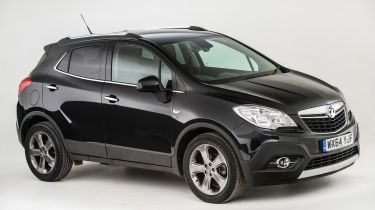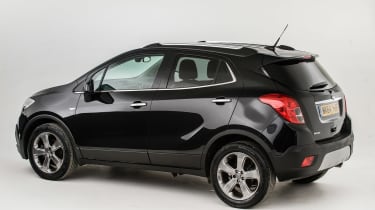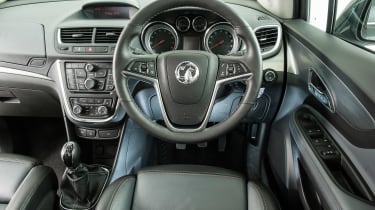Used Vauxhall Mokka (Mk1, 2012-2021) buyer's guide
A full used buyer’s guide to the Vauxhall Mokka covering the Mokka Mk1 that was on sale between 2012 and 2021
Verdict
With thousands of Mokkas and Mokka Xs for sale, you’re not going to struggle to find something that suits your needs. There are plenty of high-spec cars to go round and lots of cheaper editions, too. Unlike some of its rivals, it offers a four-wheel-drive option, which provides extra security in slippery conditions. Buying the right engine and gearbox for your needs is key; the newer engines are a big improvement over the older ones, while the Mokka X has a far better cabin than the Mokka. Having said that, neither version will raise your pulse, but you do get a lot for your money.
Vauxhall launched its first SUV way back in 1991. But while the Frontera was reasonably capable off road, it was unsophisticated and was never sought after by new or used buyers.
In 1994 the now-forgotten Monterey (a rebadged Isuzu Trooper) arrived, then in 2007 the Antara appeared. It hung around for eight years then disappeared, mourned by few.
When the Mokka reached showrooms in 2012 it was about time Vauxhall enjoyed some SUV success, and despite some underwhelming engines, the car has gone on to sell well thanks to a booming mini-SUV segment. Updates along the way have made the Mokka a little easier to recommend, too.
History
The Mokka went on sale in November 2012, priced from £15,995. There was a choice of 1.4T or 1.6 petrol engines, the former only with 4x4. A 128bhp 1.7 CDTi diesel came in six-speed manual or auto guises, the former available with 4WD.
Used - available now

2023 Hyundai
Kona Electric
13,211 milesAutomaticElectric
Cash £15,806
2021 Volkswagen
Polo
29,855 milesManualPetrol1.0L
Cash £14,183
2023 Tesla
Model 3
35,839 milesAutomaticElectric
Cash £19,700
2021 Nissan
Leaf
42,925 milesAutomaticElectric
Cash £10,083In May 2013 a front-wheel-drive 1.4T arrived in auto or manual forms, then in January 2015 a 1.6 CDTi engine was introduced alongside the 1.7 CDTi unit.
A facelifted car arrived in October 2016, now called Mokka X. Along with a refreshed exterior design, it brought a redesigned dashboard that featured improved infotainment plus a new turbocharged 1.4-litre petrol engine and fresh colour choices, along with optional adaptive LED headlights.
Which one should I buy?
The 1.4T engine is much more zesty than the 1.6 petrol, while the 1.6 CDTi is a big improvement over the 1.7 diesel. Entry-level Mokka S trim features a multifunction steering wheel, electric front windows, air-con, cruise control and steel wheels. Exclusiv adds dual-zone climate control, automatic lights and wipers, plus powered rear windows. It also brings Bluetooth, front and rear parking sensors plus 18-inch alloys.
Tech Line models also come with nav, while the range-topping SE has leather seat facings, heated front seats and steering wheel, adaptive bi-xenon lights and privacy glass. When it comes to the Mokka X’s trim levels, Exclusiv, Tech Line and SE are roughly equal to Active, Design Nav and Elite.
Alternatives to the Vauxhall Mokka Mk1
You're spoilt for choice in this class and that’s the problem for the Vauxhall; the Peugeot 2008 and Renault Captur are just as capable, and are better value.
We’d give the Ford Ecosport a miss, though; it’s not up to the brand’s usual standards. Instead check out the Mazda CX-3, which is great to drive, well made and well equipped, but you’ll pay more for one than for an equivalent Mokka.
Don’t overlook the Nissan Juke, which still looks distinctive, but isn’t as polished as you might expect. If you’re buying something fairly new, also consider the SEAT Arona, which has a smart cabin, neat styling and efficient engines.
What to look for
Handbrake
Some owners have had problems with the handbrake not holding their Mokka securely when on a steep incline.
Engine
Software issue can cause 1.4T engine in the Mokka X to hesitate when pulling away.
Headlamps
Adaptive headlights are brilliant, but can cause problems, particularly with early cars.
Cabin
Rattles can come from front windows, the storage tray under the passenger seat or the clutch pedal relay.
Interior
The Mokka X’s dashboard is much more modern than the Mokka’s, but both models feature comfortable front seats with plenty of adjustment. Rear-seat legroom is tight for adults and it’s a squeeze fitting three in there, but it’s fine for children. Boot space is no better than average, at 356 litres with the seats up or 1,372 litres with them down.
Running costs
Every Mokka needs maintenance after 12 months or 20,000 miles. Check-ups alternate between minor and major, and these cost £159 and £249 respectively.
Pay £279 every six years or 100,000 miles for a new cambelt with the 1.6-litre petrol or 1.7 CDTi engines; the 1.4T and 1.6 CDTi motors are chain-driven. There’s no set interval for replacing coolant, but fresh brake fluid is required every two years, although the cost of this is already included in the service price.
Recalls
The first of five recalls came in March 2013 because steering wheels could detach. Seatbelt pre-tensioner glitches resulted in a second campaign in August 2015.
Water leaks into an ECU led to the third in July 2016; the fourth was in November 2016 for brake light issues on cars with an integrated bike carrier. The latest action came in March 2017 because of a potential airbag fault.
Driver Power Owner Satisfaction
For what is now quite an old car, the Mokka did well to achieve a 25th place in our Driver Power 2018 survey. The undoubted high spots are the model’s infotainment systems, plus the cabin and comfort, both of which got top-10 placings; safety scored well, too. Owners are less impressed by its practicality, however.










